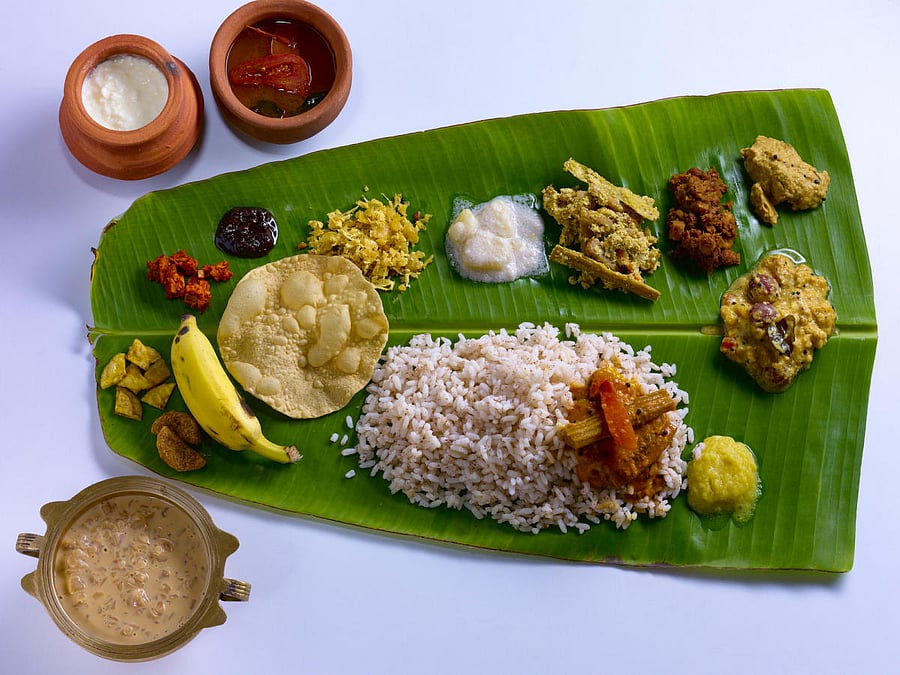
Onam is almost here. Thiruvonam day, which will be observed on August 21 this year, is always celebrated with a special meal, or the ‘Onam Sadhya’.
‘Sadhya’ means banquet in Malayalam. It’s a traditional feast of vegetarian dishes served on a banana leaf that people have while sitting on the floor. While ‘sadhya’ usually refers to a vegetarian spread, some parts of north Kerala also serve up non-vegetarian dishes.
Back in the day, family and friends would gather and cook 20 to 28 items together. But today, people either make fewer items or simply order the ‘sadhya’ box from restaurants.
Most of the dishes are an ode to the harvest festival and are mildly-spiced. And, well, salt counts as a ‘sadhya’ item too. With that trivia out of the way, let’s give you a peek into the dishes that make ‘sadhya’ the most-awaited meal of the year.
Rice: It’s the main item of the feast, without which the ‘sadhya’ cannot start. Kerala rice or semi-polished, parboiled brown rice is used. It is also called ‘Kerala matta’.
Sambar: Lentils, tamarind, and vegetables like drumsticks or tomato cooked into a thick gravy and flavoured with asafoetida makes for the traditional ‘sambhar’. Every family has their own recipe and some like to cook with beans, potatoes, and yam.
Rasam: Had as an accompaniment with rice, this watery dish is made of tomatoes, tamarind, curry leaves, mustard seeds, and spices like black pepper, asafoetida, and chili pepper. ‘Rasam’ is believed to aid digestion. However, it is not counted as part of the ‘sadhya’ in some parts of Kerala.
Parippu curry: A lentil curry, this dish is traditionally had with rice, pappadam and ghee.
Moru curry: This one is made by boiling curd to perfection with a hint of turmeric, and adding shallots, ginger and garlic later.
Avial: One of the most popular dishes of the ‘sadhya’, this thick mixture of vegetables and grated coconut is seasoned with coconut oil and curry leaves.
Kaalan: A signature ‘sadhya’ dish, ‘kaalan’ is thick and sour. It is made of curd, yam or raw bananas and grated coconut.
Olan: Made with white gourd or ash gourd, black-eyed peas, coconut milk and ginger, and seasoned with coconut oil, ‘olan’ is a light dish.
Koottukari: Vegetables like banana or yam cooked with chickpeas, coconut and black pepper make a ‘kootukari’. This is often a dry dish.
Erissery: This dish is prepared with pumpkin, red beans or black-eyed peas, and a generous portion of grated coconut, and is thick.
Kichadi: A sour curry, ‘kichadi’ is made of curd, ash gourd or cucumber, coconut, mustard seeds and curry leaves.
Pachadi: Often considered a sweet form of ‘kichadi’, this dish is made with pineapple, pumpkin or even grapes in curd, with coconut grounded with cumin seeds and green chillies. Some also make it with bitter gourd.
Pulisseri: This is a thick, sour yellow-coloured curry, made with sour curd and cucumber. Some even make a sweet variant, ‘mambazha puliseri’, where ripe mangoes and jaggery are used.
Injipuli or Inji Curry: Made from ginger, tamarind, jaggery and green chillies, this sweet pickle is usually one of the first things prepared during the Onam season.
Thoran: A side dish, this can be made from any vegetable, although beans, carrots or cabbage are commonly used along with grated coconut.
Sambharam: Buttermilk, seasoned with green chilli, ginger, curry leaves and salt, is usually drunk to help in digestion.
Mezhkkupuratti: A side dish, often yam is cut into slices/pieces and boiled with spices and fried in coconut oil. This is an optional dish in some parts of Kerala.
Banana: One ripe banana or two are often served with the feast, to be had by itself or mixed with ‘pradhaman’ or ‘payasam’.
Pappadam: ‘Pappadam’ or ‘pappads’ made from rice flour are an intrinsic part of the meal. Crushing them and mixing them with rice and accompaniments is a tradition.
Sharkara Upperi or Sharkara Varatti: These are jaggery chips or banana chips that are made out of jaggery. These can be a bit hard to bite into, but often leaves one wanting for more.
Kaaya varuthathu or Upperi: If you have a Malayali friend, you’ve definitely had the ‘upperi’. Banana chips are served in plenty.
Pradhaman and Payasam: Both these sweet dishes are served at ‘sadhya’ according to the host’s choice. While ‘pradhaman’ is made from coconut milk, ‘payasam’ is made from cow’s milk.
Some of the most common ‘pradhaman’ are ‘palada pradhaman’ (made with milk, dry fruits, and rice ada), ‘pazham pradhaman’ (made with bananas and jaggery) and ‘parippu pradhaman’ (lentils cooked with jaggery, coconut milk and ghee). The most common ‘payasam’ is the ‘semiya payasam’ (made of semolina, milk, and ghee).
Achaar: Pickles or ‘achaar’ area spicy, tangy add-on. The ‘mangakari’ (spicy mango pickle) and ‘narangakari’ (lemon pickle) are mostly served.
